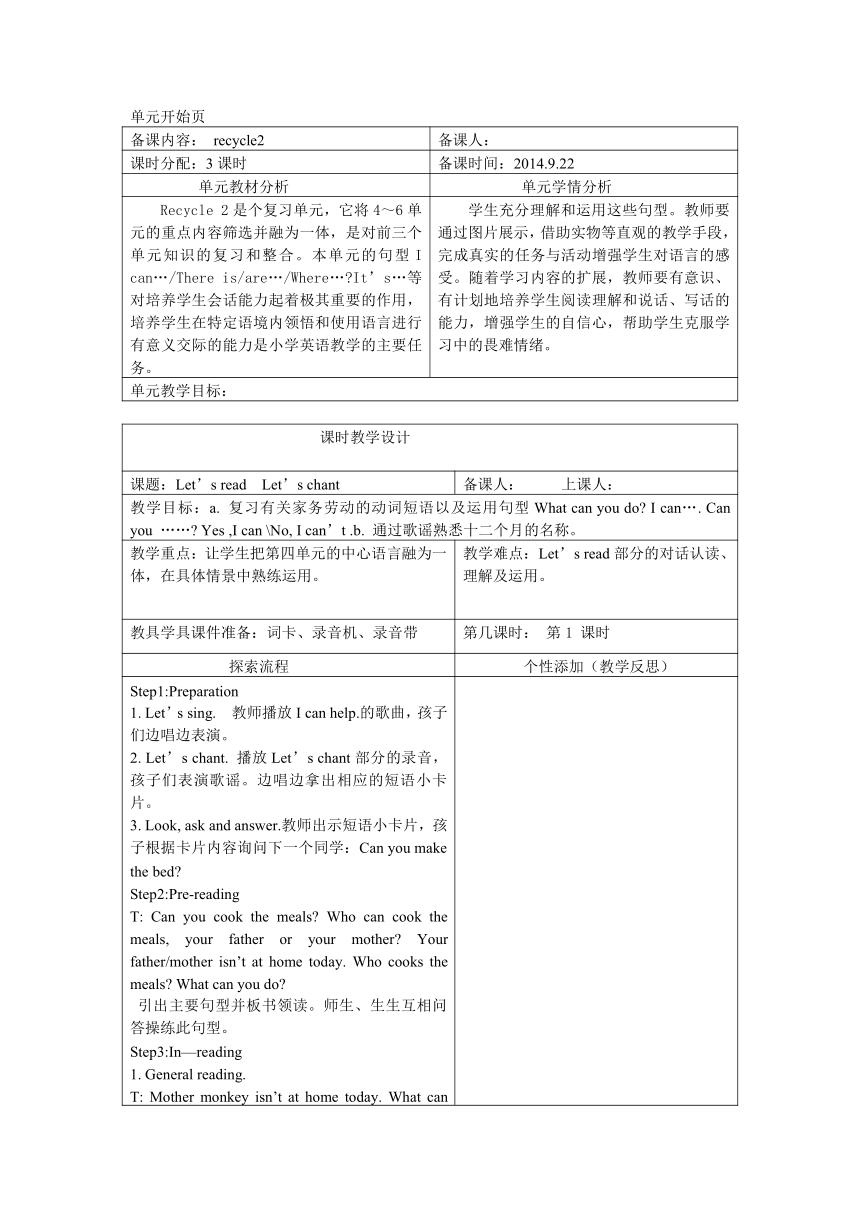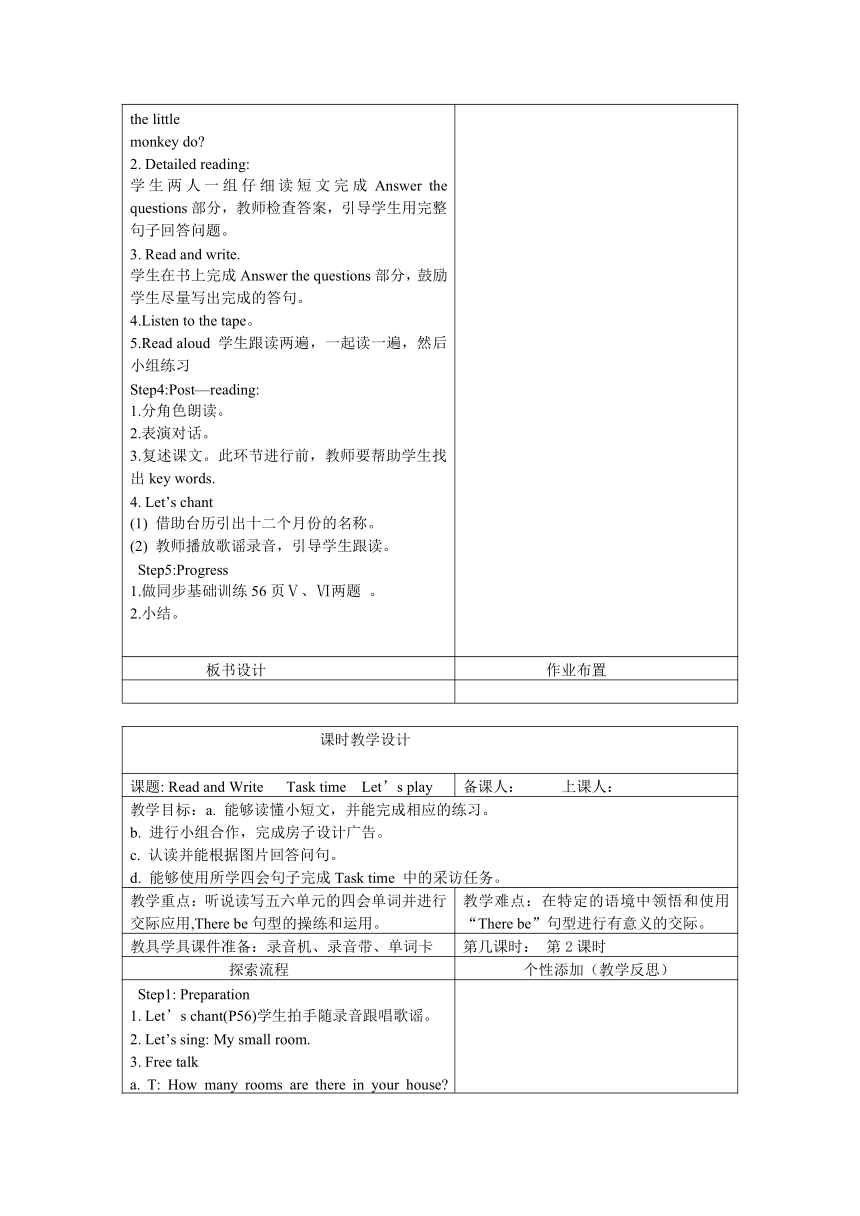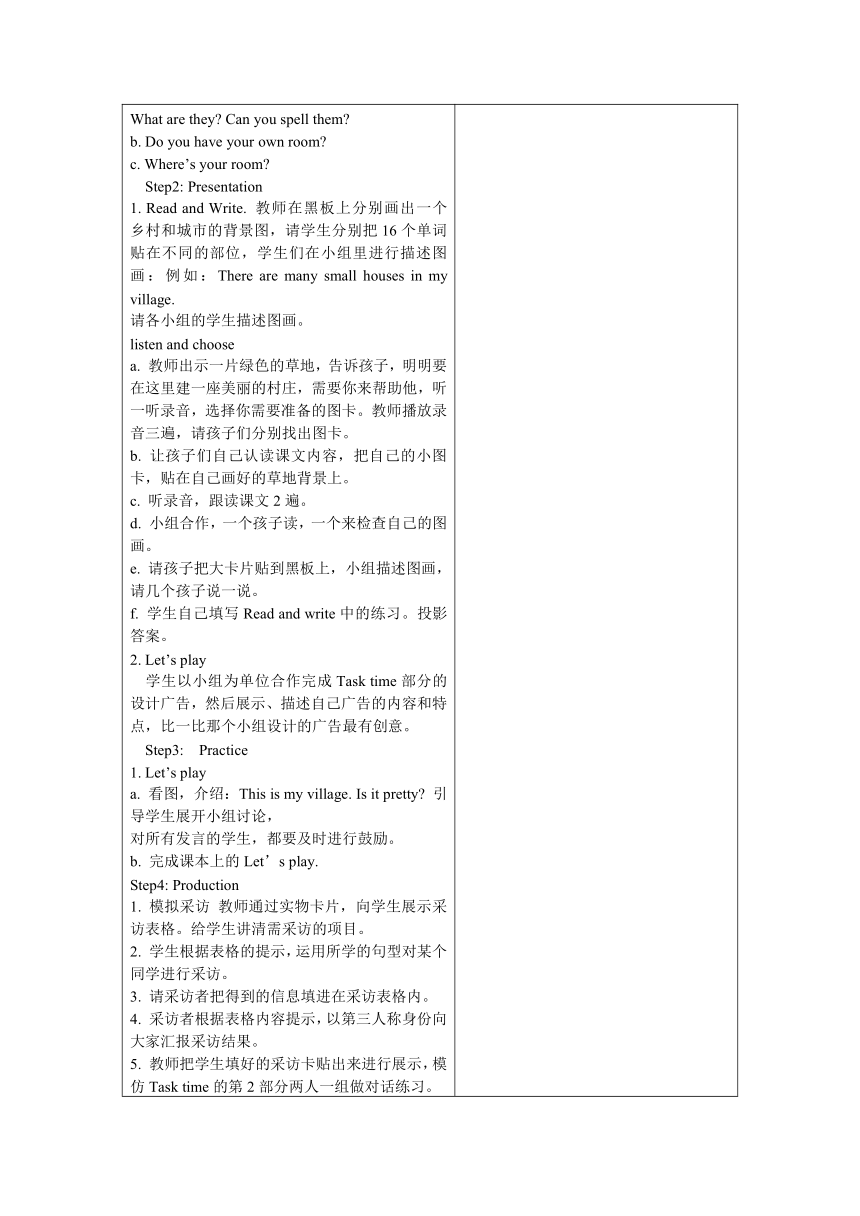Recycle 2教案
图片预览



文档简介
单元开始页
备课内容: recycle2
备课人:
课时分配:3课时
备课时间:2014.9.22
单元教材分析
单元学情分析
Recycle 2是个复习单元,它将4~6单元的重点内容筛选并融为一体,是对前三个单元知识的复习和整合。本单元的句型I can…/There is/are…/Where…?It’s…等对培养学生会话能力起着极其重要的作用,培养学生在特定语境内领悟和使用语言进行有意义交际的能力是小学英语教学的主要任务。
学生充分理解和运用这些句型。教师要通过图片展示,借助实物等直观的教学手段,完成真实的任务与活动增强学生对语言的感受。随着学习内容的扩展,教师要有意识、有计划地培养学生阅读理解和说话、写话的能力,增强学生的自信心,帮助学生克服学习中的畏难情绪。
单元教学目标:
课时教学设计
课题:Let’s read Let’s chant
备课人: 上课人:
教学目标:a. 复习有关家务劳动的动词短语以及运用句型What can you do? I can…. Can you ……? Yes ,I can No, I can’t .b. 通过歌谣熟悉十二个月的名称。
教学重点:让学生把第四单元的中心语言融为一体,在具体情景中熟练运用。
教学难点:Let’s read部分的对话认读、理解及运用。
教具学具课件准备:词卡、录音机、录音带
第几课时: 第1 课时
探索流程
个性添加(教学反思)
Step1:Preparation
1. Let’s sing. 教师播放I can help.的歌曲,孩子们边唱边表演。
2. Let’s chant. 播放Let’s chant部分的录音,孩子们表演歌谣。边唱边拿出相应的短语小卡片。
3. Look, ask and answer.教师出示短语小卡片,孩子根据卡片内容询问下一个同学:Can you make the bed?
Step2:Pre-reading
T: Can you cook the meals? Who can cook the meals, your father or your mother? Your father/mother isn’t at home today. Who cooks the meals? What can you do?
引出主要句型并板书领读。师生、生生互相问答操练此句型。
Step3:In—reading
1. General reading.
T: Mother monkey isn’t at home today. What can the little
monkey do?
2. Detailed reading:
学生两人一组仔细读短文完成Answer the questions部分,教师检查答案,引导学生用完整句子回答问题。
3. Read and write.
学生在书上完成Answer the questions部分,鼓励学生尽量写出完成的答句。
4.Listen to the tape。
5.Read aloud 学生跟读两遍,一起读一遍,然后小组练习
Step4:Post—reading:
1.分角色朗读。
2.表演对话。
3.复述课文。此环节进行前,教师要帮助学生找出key words.
4. Let’s chant
(1) 借助台历引出十二个月份的名称。
(2) 教师播放歌谣录音,引导学生跟读。
Step5:Progress
1.做同步基础训练56页Ⅴ、Ⅵ两题 。
2.小结。
板书设计
作业布置
课时教学设计
课题: Read and Write Task time Let’s play
备课人: 上课人:
教学目标:a. 能够读懂小短文,并能完成相应的练习。
b. 进行小组合作,完成房子设计广告。
c. 认读并能根据图片回答问句。
d. 能够使用所学四会句子完成Task time 中的采访任务。
教学重点:听说读写五六单元的四会单词并进行交际应用,There be句型的操练和运用。
教学难点:在特定的语境中领悟和使用“There be”句型进行有意义的交际。
教具学具课件准备:录音机、录音带、单词卡
第几课时: 第2课时
探索流程
个性添加(教学反思)
Step1: Preparation
1. Let’s chant(P56)学生拍手随录音跟唱歌谣。
2. Let’s sing: My small room.
3. Free talk
a. T: How many rooms are there in your house? What are they? Can you spell them?
b. Do you have your own room?
c. Where’s your room?
Step2: Presentation
1. Read and Write. 教师在黑板上分别画出一个乡村和城市的背景图,请学生分别把16个单词贴在不同的部位,学生们在小组里进行描述图画:例如:There are many small houses in my village.
请各小组的学生描述图画。
listen and choose
a. 教师出示一片绿色的草地,告诉孩子,明明要在这里建一座美丽的村庄,需要你来帮助他,听一听录音,选择你需要准备的图卡。教师播放录音三遍,请孩子们分别找出图卡。
b. 让孩子们自己认读课文内容,把自己的小图卡,贴在自己画好的草地背景上。
c. 听录音,跟读课文2遍。
d. 小组合作,一个孩子读,一个来检查自己的图画。
e. 请孩子把大卡片贴到黑板上,小组描述图画,请几个孩子说一说。
f. 学生自己填写Read and write中的练习。投影答案。
2. Let’s play
学生以小组为单位合作完成Task time部分的设计广告,然后展示、描述自己广告的内容和特点,比一比那个小组设计的广告最有创意。
Step3: Practice
1. Let’s play
a. 看图,介绍:This is my village. Is it pretty? 引导学生展开小组讨论,
对所有发言的学生,都要及时进行鼓励。
b. 完成课本上的Let’s play.
Step4: Production
1. 模拟采访 教师通过实物卡片,向学生展示采访表格。给学生讲清需采访的项目。
2. 学生根据表格的提示,运用所学的句型对某个同学进行采访。
3. 请采访者把得到的信息填进在采访表格内。
4. 采访者根据表格内容提示,以第三人称身份向大家汇报采访结果。
5. 教师把学生填好的采访卡贴出来进行展示,模仿Task time的第2部分两人一组做对话练习。
Step5: Progress
1. 做基础训练57页Ⅷ题。
2. 为当地的旅游点做一个小广告。
板书设计
作业布置
课时教学设计
课题:Listen and choose Pair work Let’s sing
备课人: 上课人:
教学目标:1.能够读懂Read and write的小短文,
2.根据短文内容完成相应的练习。
3.运用there be 结构描述自己的村庄。
教学重点:读懂短文、正确完成相应的练习
教学难点:正确运用there be 结构描述自己的村庄
教具学具课件准备:教学课件 班班通点读机
第几课时: 第3课时
探索流程
个性添加(教学反思)
一、猜谜:
学生根据老师给的家具、物品或景物来猜这是什么地方 listen and guess:What's this? a.T: There is a light. There is a chair. Thre is a desk.
There is a book shelf. Ss: It’s the study. b.T: there are many trees. There are many flowers .There is a lake. There are many animals.
c.Ss: This is a zoo. …
二、口语会话,复习旧知
T: What’s the weather like? What’s the date? What day is it today? Are you helpful? What can you do?
Do you like your home?Where is your house ? How many rooms are there in your house?
What’s in your room ?
三、新课呈现:
1)教师用班班通呈现上一节课的作业。
We can our .We can trees and .Just and .Our earth beautiful. There a river. are many fish I it. There a lot of trees. There are birds in it. There are many grass under the tree. I love earth.
T: Who can give us the answers? (和学生对答后利用课件呈现正确答案)
We can help our earth. We can plant trees and flowers. Just you and me. Our earth is beautiful. There is a river. There are many fish in it. There are a lot of trees. There are many birds in it. There are many green grass under the tree. I love our earth.
4.listen and write的学习 (教师播放Deng Ming 介绍village的录音。)
(1)听课文,回答问题。
T play the tape and offer some questions for the student to disscuss:
What’s in the river? What’ t over the river?
What’s near the road?
S1: There are many fish in the river. But I can not see in the picture
S2: There is a bridge over the river. But I can not see in the picture
S3: There are many flowers near the road. But I can not see in the picture
(2)读课文,完成任务。
a.接学生产生的疑问引入教学主题。 T: Yes. Boys and girs, open your books, turn to page 81.
Look at the picture and read the passage, then finish the sentences in practise 1. b.全班交流答案,并用班班通展示
(1)There isn’t a bridge over the river. (2)There are no fish in the river. (3)There are not flowers near the road.
(4)There aren’t many trees in the village.
c.教师点读,学生听音跟读课文
d.操练(Game):
T: Now close your books, please. I’m going to say the location of one of those sentences. You have to listen and complete the sentence.
T: Over the river. Ss: There is a bridge over the river.
T: Beside the river. Ss:…
T: Near the village. Ss:…
[设计意图]
利用游戏来操练,降低操练难度,提高操练的趣味性,适合小学生心理。
3)再读课文,比较完成图片。
T: Let’s draw some missing things to finish the picture.(在河里添上几条鱼,在路上添上几辆车,在路边的草地上添上一些花。)
理解课文的基础上完成画图片的真实任务。
5. 重点句型运用
板书设计
作业布置
备课内容: recycle2
备课人:
课时分配:3课时
备课时间:2014.9.22
单元教材分析
单元学情分析
Recycle 2是个复习单元,它将4~6单元的重点内容筛选并融为一体,是对前三个单元知识的复习和整合。本单元的句型I can…/There is/are…/Where…?It’s…等对培养学生会话能力起着极其重要的作用,培养学生在特定语境内领悟和使用语言进行有意义交际的能力是小学英语教学的主要任务。
学生充分理解和运用这些句型。教师要通过图片展示,借助实物等直观的教学手段,完成真实的任务与活动增强学生对语言的感受。随着学习内容的扩展,教师要有意识、有计划地培养学生阅读理解和说话、写话的能力,增强学生的自信心,帮助学生克服学习中的畏难情绪。
单元教学目标:
课时教学设计
课题:Let’s read Let’s chant
备课人: 上课人:
教学目标:a. 复习有关家务劳动的动词短语以及运用句型What can you do? I can…. Can you ……? Yes ,I can No, I can’t .b. 通过歌谣熟悉十二个月的名称。
教学重点:让学生把第四单元的中心语言融为一体,在具体情景中熟练运用。
教学难点:Let’s read部分的对话认读、理解及运用。
教具学具课件准备:词卡、录音机、录音带
第几课时: 第1 课时
探索流程
个性添加(教学反思)
Step1:Preparation
1. Let’s sing. 教师播放I can help.的歌曲,孩子们边唱边表演。
2. Let’s chant. 播放Let’s chant部分的录音,孩子们表演歌谣。边唱边拿出相应的短语小卡片。
3. Look, ask and answer.教师出示短语小卡片,孩子根据卡片内容询问下一个同学:Can you make the bed?
Step2:Pre-reading
T: Can you cook the meals? Who can cook the meals, your father or your mother? Your father/mother isn’t at home today. Who cooks the meals? What can you do?
引出主要句型并板书领读。师生、生生互相问答操练此句型。
Step3:In—reading
1. General reading.
T: Mother monkey isn’t at home today. What can the little
monkey do?
2. Detailed reading:
学生两人一组仔细读短文完成Answer the questions部分,教师检查答案,引导学生用完整句子回答问题。
3. Read and write.
学生在书上完成Answer the questions部分,鼓励学生尽量写出完成的答句。
4.Listen to the tape。
5.Read aloud 学生跟读两遍,一起读一遍,然后小组练习
Step4:Post—reading:
1.分角色朗读。
2.表演对话。
3.复述课文。此环节进行前,教师要帮助学生找出key words.
4. Let’s chant
(1) 借助台历引出十二个月份的名称。
(2) 教师播放歌谣录音,引导学生跟读。
Step5:Progress
1.做同步基础训练56页Ⅴ、Ⅵ两题 。
2.小结。
板书设计
作业布置
课时教学设计
课题: Read and Write Task time Let’s play
备课人: 上课人:
教学目标:a. 能够读懂小短文,并能完成相应的练习。
b. 进行小组合作,完成房子设计广告。
c. 认读并能根据图片回答问句。
d. 能够使用所学四会句子完成Task time 中的采访任务。
教学重点:听说读写五六单元的四会单词并进行交际应用,There be句型的操练和运用。
教学难点:在特定的语境中领悟和使用“There be”句型进行有意义的交际。
教具学具课件准备:录音机、录音带、单词卡
第几课时: 第2课时
探索流程
个性添加(教学反思)
Step1: Preparation
1. Let’s chant(P56)学生拍手随录音跟唱歌谣。
2. Let’s sing: My small room.
3. Free talk
a. T: How many rooms are there in your house? What are they? Can you spell them?
b. Do you have your own room?
c. Where’s your room?
Step2: Presentation
1. Read and Write. 教师在黑板上分别画出一个乡村和城市的背景图,请学生分别把16个单词贴在不同的部位,学生们在小组里进行描述图画:例如:There are many small houses in my village.
请各小组的学生描述图画。
listen and choose
a. 教师出示一片绿色的草地,告诉孩子,明明要在这里建一座美丽的村庄,需要你来帮助他,听一听录音,选择你需要准备的图卡。教师播放录音三遍,请孩子们分别找出图卡。
b. 让孩子们自己认读课文内容,把自己的小图卡,贴在自己画好的草地背景上。
c. 听录音,跟读课文2遍。
d. 小组合作,一个孩子读,一个来检查自己的图画。
e. 请孩子把大卡片贴到黑板上,小组描述图画,请几个孩子说一说。
f. 学生自己填写Read and write中的练习。投影答案。
2. Let’s play
学生以小组为单位合作完成Task time部分的设计广告,然后展示、描述自己广告的内容和特点,比一比那个小组设计的广告最有创意。
Step3: Practice
1. Let’s play
a. 看图,介绍:This is my village. Is it pretty? 引导学生展开小组讨论,
对所有发言的学生,都要及时进行鼓励。
b. 完成课本上的Let’s play.
Step4: Production
1. 模拟采访 教师通过实物卡片,向学生展示采访表格。给学生讲清需采访的项目。
2. 学生根据表格的提示,运用所学的句型对某个同学进行采访。
3. 请采访者把得到的信息填进在采访表格内。
4. 采访者根据表格内容提示,以第三人称身份向大家汇报采访结果。
5. 教师把学生填好的采访卡贴出来进行展示,模仿Task time的第2部分两人一组做对话练习。
Step5: Progress
1. 做基础训练57页Ⅷ题。
2. 为当地的旅游点做一个小广告。
板书设计
作业布置
课时教学设计
课题:Listen and choose Pair work Let’s sing
备课人: 上课人:
教学目标:1.能够读懂Read and write的小短文,
2.根据短文内容完成相应的练习。
3.运用there be 结构描述自己的村庄。
教学重点:读懂短文、正确完成相应的练习
教学难点:正确运用there be 结构描述自己的村庄
教具学具课件准备:教学课件 班班通点读机
第几课时: 第3课时
探索流程
个性添加(教学反思)
一、猜谜:
学生根据老师给的家具、物品或景物来猜这是什么地方 listen and guess:What's this? a.T: There is a light. There is a chair. Thre is a desk.
There is a book shelf. Ss: It’s the study. b.T: there are many trees. There are many flowers .There is a lake. There are many animals.
c.Ss: This is a zoo. …
二、口语会话,复习旧知
T: What’s the weather like? What’s the date? What day is it today? Are you helpful? What can you do?
Do you like your home?Where is your house ? How many rooms are there in your house?
What’s in your room ?
三、新课呈现:
1)教师用班班通呈现上一节课的作业。
We can our .We can trees and .Just and .Our earth beautiful. There a river. are many fish I it. There a lot of trees. There are birds in it. There are many grass under the tree. I love earth.
T: Who can give us the answers? (和学生对答后利用课件呈现正确答案)
We can help our earth. We can plant trees and flowers. Just you and me. Our earth is beautiful. There is a river. There are many fish in it. There are a lot of trees. There are many birds in it. There are many green grass under the tree. I love our earth.
4.listen and write的学习 (教师播放Deng Ming 介绍village的录音。)
(1)听课文,回答问题。
T play the tape and offer some questions for the student to disscuss:
What’s in the river? What’ t over the river?
What’s near the road?
S1: There are many fish in the river. But I can not see in the picture
S2: There is a bridge over the river. But I can not see in the picture
S3: There are many flowers near the road. But I can not see in the picture
(2)读课文,完成任务。
a.接学生产生的疑问引入教学主题。 T: Yes. Boys and girs, open your books, turn to page 81.
Look at the picture and read the passage, then finish the sentences in practise 1. b.全班交流答案,并用班班通展示
(1)There isn’t a bridge over the river. (2)There are no fish in the river. (3)There are not flowers near the road.
(4)There aren’t many trees in the village.
c.教师点读,学生听音跟读课文
d.操练(Game):
T: Now close your books, please. I’m going to say the location of one of those sentences. You have to listen and complete the sentence.
T: Over the river. Ss: There is a bridge over the river.
T: Beside the river. Ss:…
T: Near the village. Ss:…
[设计意图]
利用游戏来操练,降低操练难度,提高操练的趣味性,适合小学生心理。
3)再读课文,比较完成图片。
T: Let’s draw some missing things to finish the picture.(在河里添上几条鱼,在路上添上几辆车,在路边的草地上添上一些花。)
理解课文的基础上完成画图片的真实任务。
5. 重点句型运用
板书设计
作业布置
